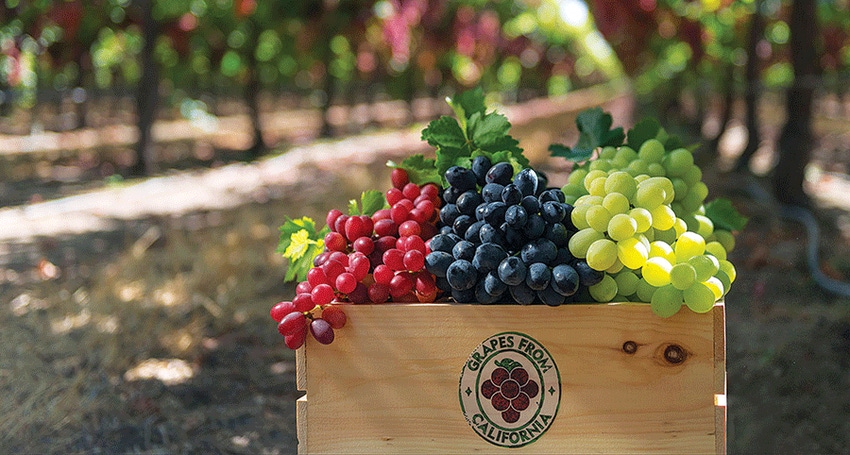
When California’s table grape growers produced more than 100 million boxes six years ago, it was seen as a major milestone. Now, it seems they run up and touch that milestone every year.
In 2017, growers produced 109.1 million boxes, with a crop value of $1.81 billion, according to new figures from the California Table Grape Commission. The value fell just short of the record $1.85 billion generated from 110 million boxes in 2016, and the $1.83 billion for 110.5 million boxes in 2015, but topped the $1.76 billion in receipts in 2014, which was then a record.
While it seemed a big breakthrough a few years ago, approaching 110 million boxes in a season “has become the new normal for California table grape growers,” says Kathleen Nave, the commission’s president.
The larger crops in recent years coincide with increases in acreage in California, according to the National Agricultural Statistics Service. Bearing acreage of table grapes rose from 82,000 in 2007 to 111,000 in 2016. In contrast, bearing acreage of raisin grapes in the state fell from 227,000 to 170,000 during that period.
Wine grapes — the most common grape type in California — increased bearing acreage from 480,000 in 2007 to 560,000 in 2016, spurred on by more lucrative grower returns and advances in labor-saving mechanization.
DOMESTIC CONSUMPTION
For table grapes, 85 percent of which are grown in Kern and Tulare counties, a majority of the crop is typically consumed domestically, the commission notes. That remained true in 2017, with 64.2 percent of the crop consumed in the U.S. and 35.8 percent going to export markets.
California table grapes were shipped to 59 countries last year, with the top six volume markets being Canada, Mexico, mainland China, the Philippines, Taiwan, and Japan.
Fresh grapes from the Golden State are harvested from May through January. Nave recently told Western Farm Press this year’s crop appears fairly robust, while growers remain concerned about labor availability and other rising costs.
Adding to many growers’ worries is trade, as grapes were included in China’s list of dozens of American agricultural goods that will face a 15 percent tariff, in addition to any existing duties. The tariffs come in retaliation for President Donald Trump’s decision to impose high tariffs on imported steel and aluminum to protect those industries domestically.
In 2015, China and Hong Kong received 3.5 million 19-pound boxes — a relatively small portion of the 110.5 million boxes produced. Still, the tariffs create openings for California’s competitors, including Peru, which recently reached a free-trade agreement with China and can send their grapes there duty-free.
GLOBAL CAMPAIGN
With a need to cultivate new trade partnerships and with the 2018 season only weeks away, the Table Grape Commission is gearing up its global campaign for California grapes, officials say.
“The commission campaign focuses on motivating the trade to promote, and consumers to buy, more California grapes more often,” Nave says.
In recent years, the commission has highlighted the health benefits of eating fresh grapes regularly. Last summer, the organization highlighted a new book, “Grapes and Health: A Monograph,” offering a review for health and science professionals of the current research linking the consumption of grapes to better health.
The 235-page compilation of peer-reviewed, grape-specific studies includes individual chapters on the fruit’s impacts on heart health, inflammation, cancer, brain health, gastrointestinal health, joint health, bladder function and eye health, according to a news release. In human studies with California grapes, eating the equivalent of 1.5 to 3 servings of fresh grapes a day has shown beneficial effects, the commission asserts.
About the Author(s)
You May Also Like






